



 18 Stimmen
18 Stimmen
Part 1: How many unique cards are there? [English]
Magic Anzahl Karten wie viele FAQ jemals wieviele Zahl Magickarten gibt
What defines a Magic: The Gathering card?
The variety of Magic card types and releases forces us to find a definition on what we call a Magic card and what we don’t. Necessarily, the final result depends on our definition.
While we all regard creature and artifact cards as Magic cards, there are more controversial cases in many different design and production slots some of which can hardly be considered as Magic cards at all. Let’s focus on these dubious candidates first before we can start counting. And doing so, maybe it’s best to start very basic.
Ad cards/Tips & Tricks cards
Ad cards (not to be confound with promo cards) as well as Tips & Tricks cards can be found in booster packs. They contain promotion for and information about the game. They have the same size as regular Magic cards and feature artworks in almost all cases. Some of them show the “TM & © 20XX Wizards of the Coast LLC.” lettering, others don’t. So even if this was a criterion, it would be a lousy one. These ad cards don’t even have a blue layer what makes them easily distinguishable from regular Magic cards. But what really disqualifies them is the fact that they aren’t even part of the actual game. While you could still refer to them as “Magic cards” if you wanted to, let’s agree they are not part of our definition.
Token cards
This distinction is less clear when it comes to token cards. These actually are a functional part of the game. You can play them, tap them, lose them, they can even win you the game. They don’t have a blue layer either, however. But why does it sound strange to speak of “token cards” in the first place? Because the game says so. Rule 108.2 (Comprehensive Rules) says: “Tokens aren’t considered cards”. That’s as clear as it can get. This is also the reason why we tend to speak of “tokens” instead of “token cards”.
Yet who are we to let us dictate anything by a rules text? The rules care about ingame logic only so we are free to decide what we want to count. And as a matter of fact, here’s the complete excerpt from rule 108.2: “Tokens aren’t considered cards—even a card that represents a token isn’t considered a card for rules purposes.” The last part is the important one. It indicates that there exist other purposes as well.
Unfortunately, other problems emerge. There are cards like Tetravus that produce tokens which never happened to be represented by actual cards. Does this mean a 1/1 white Human creature token is a Magic card whereas a 1/1 colorless Tetravite artifact creature token is not? Should we count such virtual cards, too?
I let this up to you. I will omit them on this blog entry for various reasons (mainly because I want to focus on cards you can build decks with). I understand that you might have a different point of view. Maybe you prefer to treat them equally due to their own unique artwork and design. If you want to, you can simply add in the number of existing tokens to the result at the very end of this blog entry.
Silverbordered, Unglued/Unhinged, Funny cards
The cards from these two editions were never meant to be mixed with other Magic cards. They are spoof cards, but fully playable anyway (even though the matches may differ from serious ones). For focusing purposes let us decide to exclude them from our calculation. Also because it would be a topic of its own to decide whether cards like B.F.M. (Big Furry Monster) or Who (Who/What/When/Where/Why) are single or multiple cards. According to magiccards.info, Unglued contains 88 cards while Unhinged contains 141 cards which sums up to 229. If you want to add those, be sure to reduce this number by ten as both editions contain a set of basic lands that is perfectly legal in constructed formats and would be counted multiple times otherwise.
There are 14 funny additional cards like Robot Chicken or 1996 World Champion not released in the Un-sets that are also forbidden in any regular format. That sums up to 233 funny cards in total (magiccards.info says 236 but I’ll speak about the details later).
Now that I think you got the general idea of different perspectives on how to count the cards, let’s jump over all the remaining card categories very quickly:
Other “strange” cards (including Plane/Conspiracy/Hero/Elite/Challenge/Vanguard/Scheme/Checklist/Special/Tribal/Snow-covered)
There are plenty of card types you can’t build tournament-legal decks with. You don’t want to count those, do you? If you decide to include oversize Plane cards (only legal in Planechase format), that’d be 78 cards. There are 13 Conspiracy cards which are illegal in constructed formats. Hero and Elite describe card supertypes that aren’t legal in regular Magic at all. So far, there exist 21 Hero and 4 Elite cards. Nor will we count those neither will we include any other cards from a constructed-illegal challenge deck (otherwise add additional 41 cards). Vanguard cards are only legal in Vanguard format. There exist 32 different cards and another 75 in Magic: The Gathering Online. Then there are 50 Archenemy-legal oversize scheme cards, two checklist cards from Innistrad and Dark Ascension that are used as replacements for double-sided cards. Any of the cards mentioned above won’t be counted in the calculation below (well, not directly below, feel free to scroll down a bit if you’re curious). The only “strange” card types we will indirectly count are tribal and snow-covered cards. This is because they are counted anyway since no tribal or snow-covered card has been released so far that doesn’t already have one of the regular (= constructed legal) card types.
Promo cards/Premium cards/Reprints/Misprints/Languages
For reasons of practicability and availability of information, I’ve decided we won’t count promo and premium (foil) versions individually. Same goes for reprints (even if they underwent changes as in rarity or artwork), misprints and different language versions. Otherwise we’d have to count each basic land about five hundred times. I think you will most likely agree with this unless you’re “the one” die-hard collector.
However, stating the obvious, I will count functional reprints. This means Gloomhunter and Kelinore Bat are two different cards. Just to be clear on this matter.
Unreleased cards
Let us close this whole definition part with one final notice: There are cards that have been produced and/or announced but never been published. Or at least not yet. Let us agree that we can only “see” cards that have been released. Or sold if you will. This means, as of December 2014 we won’t count spoiled cards from “Fate Reforged” even though we already know they will exist in the near future.
Now that we know what to count, how do we do it?
Getting started
Since we have completely and successfully outlined our definition now (mostly by method of elimination), all we need to do is to add together whatever is left. But first we need to find a database that serves as an index of existing cards. I personally prefer magiccards.info over gatherer.wizards.com. Yes, using an unofficial database is a risk because we cannot check if something is still missing but I’ve never had the issue of not finding any regular card (as defined above) using magiccards.info. You should be able to reproduce our counting method on the Gatherer. I’d be delighted if someone would verify the result this way and left me a short notice.
The database from magiccards.info offers a fully customizable search function. This is important because due to a limit of only 3,000 cards to be displayed at a time, we cannot simply list all cards in one single click. So we need to split up our querys. Though we need to be careful to not mix things up:
Paying attention to multiple card types
You know what happens when you add the number of lands to the number of creatures? You count Dryad Arbor twice. The easiest way to prevent this from happening is to treat each combination of card types separately. We don’t want to mix creatures with artifacts so we search for “t:creature –t:artifact” (“t:” stands for the “card type” parameter). But we also don’t want enchantment creatures or we’d risk to count them twice when counting enchantments later - and so on. So let’s search for “t:creature –t:artifact –t:enchantment –t:land”. After that we search for nonartifact, noncreature enchantments, nonenchantment, noncreature artifacts, enchantment creatures, artifact creatures and any other existing combination of card types we can think of. If a group does still contain more than 3,000 cards we further divide this group by color. But we need to be careful with multicolored cards, we don’t want to count those more than once either. So once again, we count multicolored creatures apart from monocolored ones.
Troubleshooting
Don’t worry, I did all the work and recorded each individual constellation. I even separated the calculations by constructed format for further statistical analyses. But unfortunately this isn’t our journey’s end as we need to take care of several sticking points that we stumble over when using magiccards.info as database. To comprehend the following it is important to know how the database handles certain issues.
So how many cards is – let’s say Insectile Aberration? Is it one? Two? None? A half? That totally depends on the way you look at the topic. As for the database someone must’ve figured out it was most helpful or obvious to add both sides of a double-faced card separately. There’s nothing wrong in doing so. Yet it distorts our result as I prefer to count the front sides of double-faced cards only. This refers to the side which can be cast normally and be treated as a card in every manner cards can be played. So just for our calculation I will treat Insectile Aberration as if it didn’t exist (even though it may seem very present in Modern format). The same counts for all other double-faced cards from Innistrad and Dark Ascension.
But that’s only one third of the solution as there is another card layout that shares the issue: Flip cards. Rather than flipping them to their back side, you rotate them from top to bottom. Again we won’t include those bottom halfs in our equation.
A third similar case comprises split cards. Other than double-faced and flip cards, both of the cards’ “subcards” are equal. There is no main state of the card than can be changed into another (mostly because they aren’t permanents at all). Here it’s just a question of personal opinion whether you count them once or twice. As they both are printed on one single physical card I will count them once only. Besides that, split cards from Dragon’s Maze are mechanically linked to one another via the Fuse mechanic what reinforces our impression to regard them as single cards.
This goes hand in hand with the MtG comprehensive rules that speak of halves, back sides and alternative names rather than of individual cards. It’s just that we have to be aware of certain misrepresentations when using databases due to technical issues.
Since this isn’t already complicated enough, another problem comes into place: There are cards that even change the card type if they’re flipped. Elbrus, the Binding Blade becomes Withengar Unbound, for example. While Withengar can be found in the database via any of its characteristics, we don’t want to count it or any analogous instance like Ghastly Haunting in the first place. So we need to identify and substract those hidden twins, one of which is Garruk, the Veil-Cursed.
Just for transparency, here are some hard numbers: For Legacy, we need to reduce the sorceries by 18 and instants by 20. We have also to substract six enchantments, one artifact, one creature and one planeswalker.
Remember about the funny card’s total number shown on magiccards.info that differs from our own result? That’s because the database regards the split card Who/What/When/Where/Why as five separate cards (a convention we don’t share). On the other hand, it counts B.F.M. (Big Furry Monster) only once even though it was printed on two different cards with two distinct card ids. That’s because the database can’t handle cards with same names. While we don’t count those anyway I thought I’d at least explain this to you.
Results
Amount of legal cards per tournament format
Now it’s time to finally sum up all our work. In the table below you’ll find the amounts of all cards divided by card type and tournament format as of December 2014 (I might update these data from time to time):
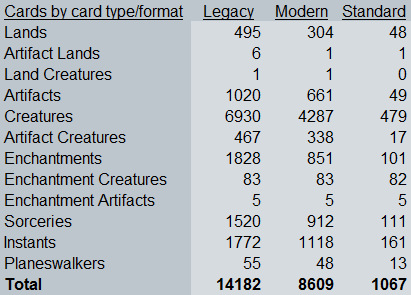
Since we now have this information, we can as well do some basic calculations:
- 60,70% of Legacy cards are legal in Modern format (difference of 5,573 cards)
- 7,52% of Legacy cards are legal in Standard format (difference of 13,115 cards)
- 12,40% of Modern cards are legal in Standard format (difference of 7,542 cards)
- Relatively, there are 28% more nonbasic lands, 39% less noncreature artifacts, 18% more instants and 158% more Planeswalkers in Standard than in the eternal formats (averaged)
- Ten years from now, if you expect the eternal formats to grow by 5,000 cards, Modern will contain roughly 71% of Legacy-legal cards whereas Standard will represent only 5,5% of cards, not even having put the new Standard rotation model into perspective
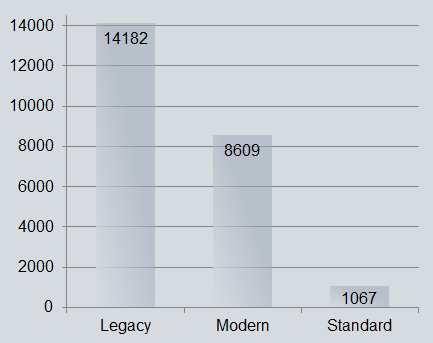
To Vintage and beyond
You may wonder why I stopped counting at Legacy while there are even more cards to discover. Well, I didn’t. But who cares about Vintage anyway? For those of you who do, there are 48 Vintage-legal, Legacy-banned cards what results in 14,230 cards which is also the highest number of cards to choose from for any legal deck building.
There are 12 Vintage-banned cards (ten of which care about the ante-zone, the others being Chaos Orb and Falling Star). Add those to the pot and you’ll get 14,242.
In one final step, let’s act crazy and add all the funny, Conspiracy, Plane, Hero, Challenge deck, Vanguard, Vanguard (MTGO), Archenemy and Checklist cards, too. We’ll stop our gedankenexperiment at 14,790 cards counted this way. If you actually are interested in different reprints, languages, Insectile Aberrations and maybe even tokens, I have to leave this to you guys. I’m sorry.
I hope you enjoyed this excursion and got a valuable but trivial insight into the dimensions of the Magic: The Gathering tournament formats. I tried to consider all kinds of intention behind the question for the exact card count. As a direct consequence of the highly diverse, dynamic and complex structure of Magic and all its cards and formats, this however can only be a preliminary result in a never-ending task. So I'll try to at least refresh this date once a year.
The next part of my blog series will contain some further math but I think you’ll find it interesting anyway. If you liked this topic, I’d love to see you back again!
Until then, thanks for your time and all the best!
Lee
- » Arcanis «, Dementia Master, Byblos und 2 andere haben sich bedankt


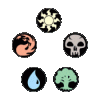








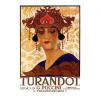


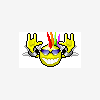

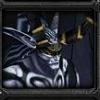




Warum ist das auf Englisch verfasst? Das hier ist eine Deutschsprachige Seite. Wenn du schon etwas auf Englisch veröffentlichst, dann mach es auf einer englischsprachigen Seite z.b. TheSource. Oder willst du uns hier nur beweisen, wie gut du Englisch kannst?